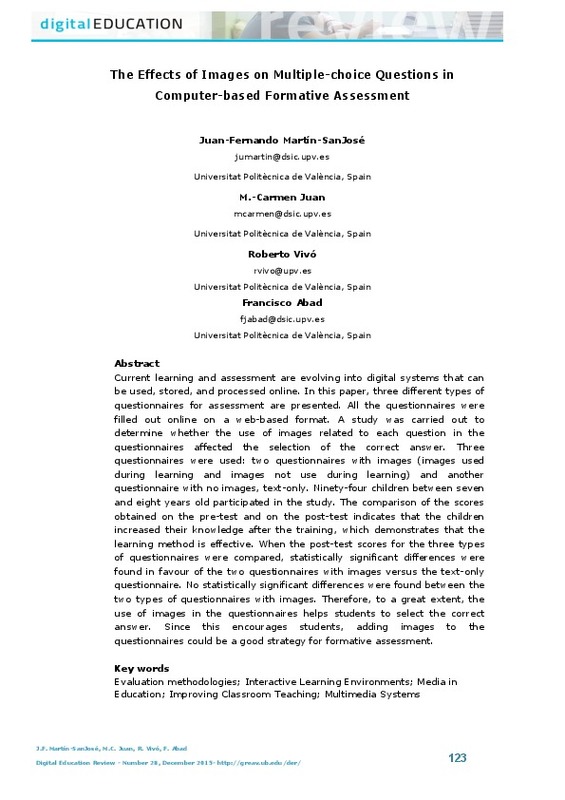JavaScript is disabled for your browser. Some features of this site may not work without it.
Buscar en RiuNet
Listar
Mi cuenta
Estadísticas
Ayuda RiuNet
Admin. UPV
The effects of images on multiple-choice questions in computer-based formative assessment
Mostrar el registro sencillo del ítem
Ficheros en el ítem
| dc.contributor.author | Martín San José, Juan Fernando
|
es_ES |
| dc.contributor.author | Juan, M.-Carmen
|
es_ES |
| dc.contributor.author | Vivó Hernando, Roberto Agustín
|
es_ES |
| dc.contributor.author | Abad Cerdá, Francisco José
|
es_ES |
| dc.date.accessioned | 2016-10-31T12:49:49Z | |
| dc.date.available | 2016-10-31T12:49:49Z | |
| dc.date.issued | 2015-12 | |
| dc.identifier.issn | 2013-9144 | |
| dc.identifier.uri | http://hdl.handle.net/10251/73001 | |
| dc.description.abstract | Current learning and assessment are evolving into digital systems that can be used, stored, and processed online. In this paper, three different types of questionnaires for assessment are presented. All the questionnaires were filled out online on a web-based format. A study was carried out to determine whether the use of images related to each question in the questionnaires affected the selection of the correct answer. Three questionnaires were used: two questionnaires with images (images used during learning and images not use during learning) and another questionnaire with no images, text-only. Ninety-four children between seven and eight years old participated in the study. The comparison of the scores obtained on the pre-test and on the post-test indicates that the children increased their knowledge after the training, which demonstrates that the learning method is effective. When the post-test scores for the three types of questionnaires were compared, statistically significant differences were found in favour of the two questionnaires with images versus the text-only questionnaire. No statistically significant differences were found between the two types of questionnaires with images. Therefore, to a great extent, the use of images in the questionnaires helps students to select the correct answer. Since this encourages students, adding images to the questionnaires could be a good strategy for formative assessment | es_ES |
| dc.language | Inglés | es_ES |
| dc.publisher | Universitat de Barcelona | es_ES |
| dc.relation.ispartof | Digital Education Review (antes Interactive Educational Multimedia) | es_ES |
| dc.rights | Reconocimiento - No comercial - Sin obra derivada (by-nc-nd) | es_ES |
| dc.subject | Evaluation methodologies | es_ES |
| dc.subject | Interactive Learning Environments | es_ES |
| dc.subject | Media in Education | es_ES |
| dc.subject | Improving Classroom Teaching | es_ES |
| dc.subject | Multimedia Systems | es_ES |
| dc.subject.classification | LENGUAJES Y SISTEMAS INFORMATICOS | es_ES |
| dc.title | The effects of images on multiple-choice questions in computer-based formative assessment | es_ES |
| dc.type | Artículo | es_ES |
| dc.rights.accessRights | Abierto | es_ES |
| dc.contributor.affiliation | Universitat Politècnica de València. Escuela Técnica Superior de Ingenieros Industriales - Escola Tècnica Superior d'Enginyers Industrials | es_ES |
| dc.contributor.affiliation | Universitat Politècnica de València. Escola Tècnica Superior d'Enginyeria Informàtica | es_ES |
| dc.description.bibliographicCitation | Martín San José, JF.; Juan, M.; Vivó Hernando, RA.; Abad Cerdá, FJ. (2015). The effects of images on multiple-choice questions in computer-based formative assessment. Digital Education Review (antes Interactive Educational Multimedia). (28):123-144. http://hdl.handle.net/10251/73001 | es_ES |
| dc.description.accrualMethod | S | es_ES |
| dc.relation.publisherversion | http://revistes.ub.edu/index.php/der/article/view/11611 | es_ES |
| dc.description.upvformatpinicio | 123 | es_ES |
| dc.description.upvformatpfin | 144 | es_ES |
| dc.type.version | info:eu-repo/semantics/publishedVersion | es_ES |
| dc.description.issue | 28 | es_ES |
| dc.relation.senia | 299826 | es_ES |






